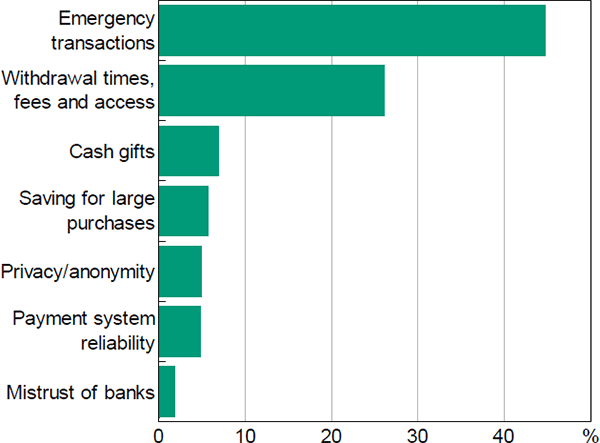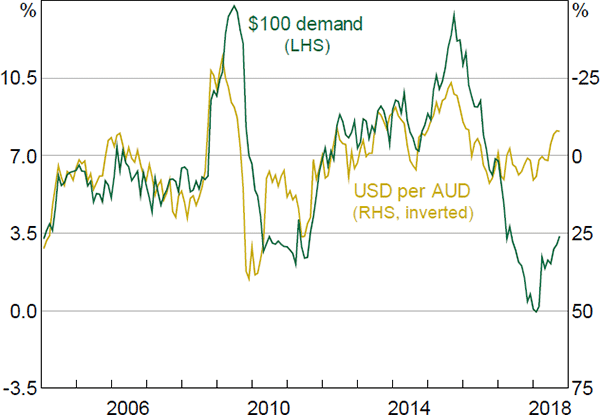RDP 2018-12: Where's the Money? An Investigation into the Whereabouts and Uses of Australian Banknotes 6. Hoarding
December 2018
- Download the Paper 1,608KB
The final component of currency demand that we examine is hoarding, which can be done either by Australian residents (domestic hoarding) or by foreigners (international hoarding). Hoarding refers to banknotes actively held by people for reasons other than to finance everyday payments, and so excludes the transactional stock of banknotes (both legitimate and shadow economy), and banknotes that have been lost. Evidence from the 2016 CPS suggests that approximately 70 per cent of Australians hold cash outside of their wallets, and that they do so for a variety of reasons including as a store of wealth, for use in emergencies, a desire for privacy, and as a backup in case of problems with electronic payments systems (Figure 18).[20] The existence of asset means-testing for various social benefits in Australia, and more generally the desire to hide assets from tax authorities, also provides an incentive for Australians to hold assets in a form that is hard to trace. We now turn to estimating the level of hoarding using a variety of different methods.

Note: Per cent of CPS respondents who hold cash outside of wallet
Source: Authors' calculations, based on data from Ipsos and RBA
6.1 One Minus Transactional Demand
While we presented the banknote life, banknote processing, velocity and seasonality methods as indirect estimates of transactional cash demand, they can equally be seen as indirect estimates of hoarding demand. The banknote life method suggested that 20–40 per cent of outstanding banknotes were used to facilitate transactions (legal and shadow economy), implying that 60–80 per cent are used for non-transactional purposes. Subtracting our estimates of lost banknotes (Section 3; 5–10 per cent) suggests hoarding in the range of roughly half to three-quarters of total outstanding banknotes, with the results of Section 5.3.2 implying that up to 1 percentage point of this could be the hoarding of profits from criminal activity. The other methods give broadly similar results.
6.2 Domestic Hoarding: Fire-damaged Banknote Claims
One way the Reserve Bank sees evidence of domestic hoarding is through its Damaged Banknotes Facility. Subject to the claim requirements of the Reserve Bank's Damaged Banknotes Policy, the Reserve Bank pays value for damaged banknotes to ensure that holders of Australian banknotes do not face financial hardship in the event that their banknotes are accidentally damaged. To make a claim, a claim form must be completed by the claimant, including an explanation on how the banknotes were damaged or acquired by the claimant. For this section, we take all claims that listed the value of the damaged banknotes as $300 or higher as evidence of domestic hoarding.
To estimate total domestic hoarding we make use of data on the number of uncontained residential fires that spread beyond the object or room of origin.[21] In particular, we make the following assumptions (we discuss the validity of these after presenting our estimates):
- all fire-affected households that hoarded banknotes lost those banknotes in the fire, made claims to the Reserve Bank for their full value, and listed ‘fire damage’ as the cause of damage;
- households affected by fires are representative of all Australian households; and
- residential fires are random and unpredictable.
We can then estimate average household banknote hoarding using the following equation:
Scaling this by the number of households in Australia gives an estimate of total domestic hoarding.
6.2.1 Results
For each fire-damaged banknote claim, two values are recorded: the value of banknotes the claimants stated were destroyed, and the value paid by the Reserve Bank after assessment. Taking these as upper and lower bounds, data for the four years to 2017/18 suggest that Australian households hoard between 2 and 3 per cent of banknotes on issue, or approximately $60 to $90 per Australian on average. By value, claims are roughly evenly split between $50 and $100 denominations, with relatively few claims for other denominations.
However, our estimates are only reliable if our assumptions are reasonable, which we believe is probably not the case. This likely causes us to underestimate total cash hoarding. We briefly highlight some of the key issues.
- Fire-affected households are unlikely to be representative of the population, with factors such as the wealth and occupation of the inhabitants of the dwelling, as well as the geographic location, likely to influence the probability of a fire.
- Related to this, if wealthier households are more likely to hoard cash, then the probability of suffering a fire may be negatively related to the probability of hoarding cash: wealthier households are arguably less likely to be fire-affected because their homes are more likely to be built out of modern materials, have working fire alarms, and be located in cities near emergency services. This will lead us to underestimate hoarding. Conversely, if wealthier households are less likely to hoard cash, then by the previous argument, our estimates may contain some upward bias.
- Cash hoarding may also directly influence the likelihood of a fire: households that store large sums of cash may invest relatively more in fire prevention methods to protect their cash holdings, again leading to underestimates of hoarding.
- Fire-damaged banknote claims may underestimate cash holdings of fire-affected houses. This will occur when stored banknotes survive a fire or when households fail to make a claim to the Reserve Bank (perhaps because they claim via their home insurance instead, or do not know about the Reserve Bank's policy on damaged banknotes).
6.3 Domestic Hoarding: Results from the Consumer Payments Survey
Another sample available to us is the Reserve Bank's Consumer Payments Survey. In 2013 and 2016, survey respondents were asked to select a range that described the amount of cash they held outside their wallets. Scaling these results to economy-wide levels, we estimate that domestic cash hoarding is in the range of roughly 10 to 20 per cent of total outstanding banknotes.[22] Although this estimate exceeds that made using damaged banknote claims, we believe it is likely still an underestimate, as those with large physical cash holdings may be less likely to participate in a survey, and, even if they do, might be hesitant to respond with the true extent of their holdings. More generally, the distribution of hoarded cash is likely to have a long right tail, which makes accurately estimating the extent of hoarding using a relatively small sample difficult.
6.4 International Hoarding: Outflow Less Inflow
The Reserve Bank has previously noted that overseas demand for Australian banknotes is an increasingly important component of overall currency demand (Flannigan and Parsons 2018). This is highlighted by a historically strong relationship between the exchange rate and demand for $100 banknotes; depreciations in the Australian dollar are associated with an increase in demand, although the relationship appears to have weakened somewhat of late (Figure 19). While much of this demand is likely the result of foreign tourists obtaining Australian currency before arriving in Australia, and subsequently spending the cash in Australia, some may be hoarded abroad indefinitely for store of value and wealth diversification purposes.

Sources: RBA; Refinitiv
To estimate overseas hoarding we first estimate the value of Australian banknotes flowing out of Australia; such outflows can occur via a number of channels, although the most significant appears to be international wholesale currency shipments that transport Australian banknotes to foreign banks and bureaux de change. From this gross outflow, we deduct an estimate of Australian currency that re-enters Australia; the largest component here is tourist spending, which we estimate as total tourist spending in Australia less the estimated portion of spending done using electronic means of payment or via banknotes obtained in Australia.
There is considerable judgement involved in these calculations, and reasonable assumptions lead to an estimate of net banknote outflows over the past decade or so (i.e. additions to the stock of internationally hoarded Australian banknotes) of between 0 and 15 per cent of total outstanding banknotes. It is important to note, however, that even this large range could be wrong as it is calculated as the residual of two imprecisely estimated quantities.[23]
6.5 Overall Assessment
As noted in Section 6.1, our best guess is that roughly half to three-quarters of outstanding banknotes are hoarded in some form, although we are only able to identify a portion of this using direct estimation methods (10–20 percentage points as domestic hoarding and up to 15 percentage points as international hoarding).
By way of comparison, Uhl and Bartzsch (2018) use direct and seasonality methods to estimate that, of euro banknotes issued by the Deutsche Bundesbank, 40–50 per cent are hoarded outside the euro area and 25 per cent are domestically hoarded in Germany (with 20–30 per cent in euro area countries other than Germany and 5–10 per cent used for transactions in Germany). For the euro area as a whole, Lalouette and Esselink (2018) suggest that around one-third of euro banknotes are hoarded domestically, and that around 30 per cent are held outside of the euro area, although the authors note that the estimates should be viewed with a considerable degree of caution given the number of assumptions required to form them. For the United States, Judson (2012) uses a range of techniques to estimate that half to three-quarters of all US currency by value was held abroad at end 2011, while Feige (2012) uses a direct method to estimate that a quarter of US currency was held abroad at end 2011. Of results based on household data, Fish and Whymark (2015) estimate that 5–10 per cent of UK banknotes are hoarded (survey based; similar to us they note that this is likely to be an underestimate), and Gresvik and Kaloudis (2001) estimate that 5 per cent of Norwegian banknotes are hoarded (based on declared cash holdings on tax returns).
Footnotes
For example, the Red Cross lists ‘extra cash’ as a minimum requirement of a survival kit for use in an emergency or disaster scenario; available at <https://www.redcross.org/get-help/how-to-prepare-for-emergencies/survival-kit-supplies.html>. [20]
Data available from <https://www.pc.gov.au/research/ongoing/report-on-government-services/2018/emergency-management/emergency-services>. [21]
The CPS asks respondents to select a bucket that their cash holdings fall into, from ‘$1–$100’ through to ‘more than $5,000’. We take the midpoint of each value bucket, or $10,000 for the top, open-ended, bucket, as the average hoarding of each respondent within each bucket, and scale up the results to be representative of the adult population. For those who did not answer (2013 and 2016 surveys) or chose ‘prefer not to answer’ (2016 survey only), we set their cash hoarding as the weighted average of those who did answer. For 2013 we estimate cash hoarding of 20 per cent of outstanding banknotes, while for 2016 the estimate is lower at roughly 10 per cent, indicating that a large degree of sampling error exists in these estimates. [22]
An alternative approach is to scale estimated offshore holdings of US banknotes by the ratio of Australian dollar to US dollar assets in official reserve portfolios. Doing this implies that somewhere between 20 and 60 per cent of outstanding Australian banknotes are held offshore. This assumes that offshore physical currency holdings by any entity are held in the same proportions as offshore official reserve asset holdings, which may not be the case, however. [23]